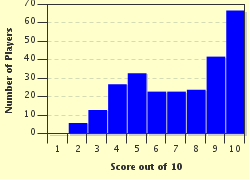Quiz Answer Key and Fun Facts
1. What is a person supposed to do when they encounter the symbol in the photo?
2. How long is a person supposed to hold onto the note shown, assuming the time signature is 2/4?
3. The two notes shown are an octave apart.
4. If music is written in the time signature indicated, which note can't be part of a measure?
5. Given the clef provided, what note would be placed on the lowest line of the staff?
6. When someone encounters the symbol shown, what should that person do?
7. How is the note shown to be played?
8. What note would have the same pitch as the note shown in the photo?
9. Is the note seen an accidental?
10. What is the classification of the musical instrument shown?
Source: Author
Buddy1
This quiz was reviewed by FunTrivia editor
ertrum before going online.
Any errors found in FunTrivia content are routinely corrected through our feedback system.

